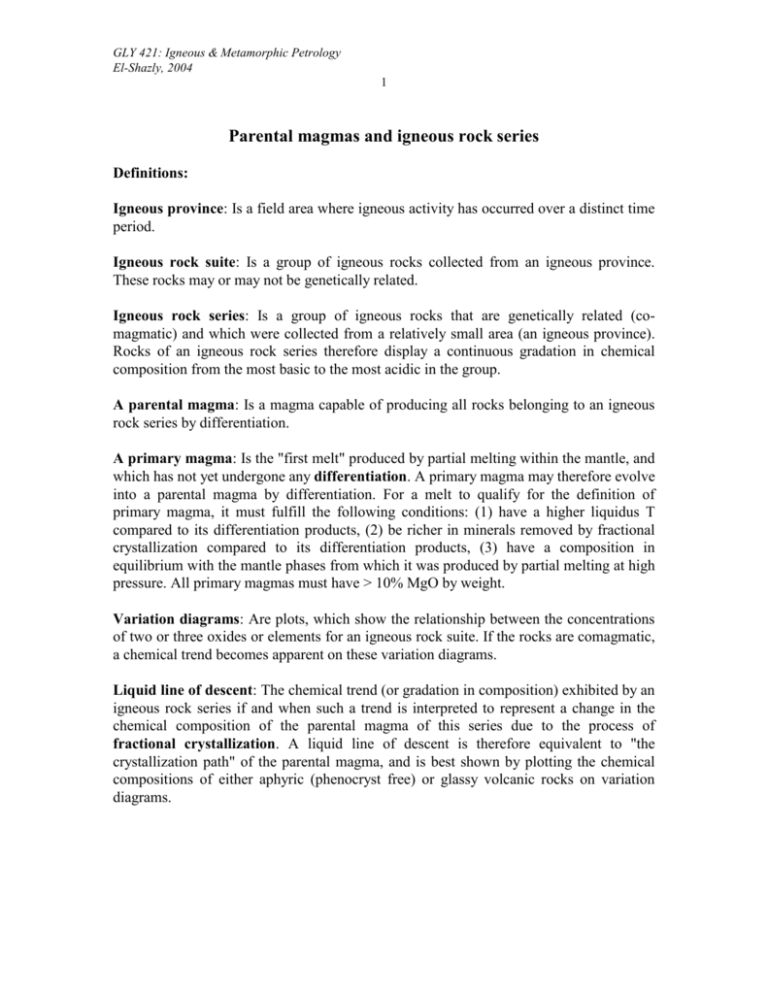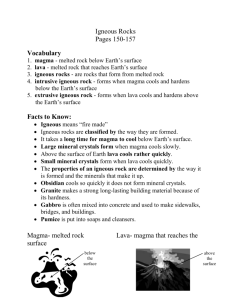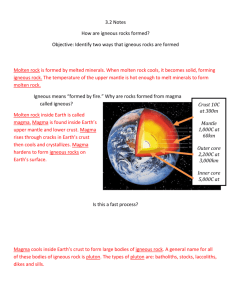Parental magmas and igneous rock series
advertisement

GLY 421: Igneous & Metamorphic Petrology El-Shazly, 2004 1 Parental magmas and igneous rock series Definitions: Igneous province: Is a field area where igneous activity has occurred over a distinct time period. Igneous rock suite: Is a group of igneous rocks collected from an igneous province. These rocks may or may not be genetically related. Igneous rock series: Is a group of igneous rocks that are genetically related (comagmatic) and which were collected from a relatively small area (an igneous province). Rocks of an igneous rock series therefore display a continuous gradation in chemical composition from the most basic to the most acidic in the group. A parental magma: Is a magma capable of producing all rocks belonging to an igneous rock series by differentiation. A primary magma: Is the "first melt" produced by partial melting within the mantle, and which has not yet undergone any differentiation. A primary magma may therefore evolve into a parental magma by differentiation. For a melt to qualify for the definition of primary magma, it must fulfill the following conditions: (1) have a higher liquidus T compared to its differentiation products, (2) be richer in minerals removed by fractional crystallization compared to its differentiation products, (3) have a composition in equilibrium with the mantle phases from which it was produced by partial melting at high pressure. All primary magmas must have > 10% MgO by weight. Variation diagrams: Are plots, which show the relationship between the concentrations of two or three oxides or elements for an igneous rock suite. If the rocks are comagmatic, a chemical trend becomes apparent on these variation diagrams. Liquid line of descent: The chemical trend (or gradation in composition) exhibited by an igneous rock series if and when such a trend is interpreted to represent a change in the chemical composition of the parental magma of this series due to the process of fractional crystallization. A liquid line of descent is therefore equivalent to "the crystallization path" of the parental magma, and is best shown by plotting the chemical compositions of either aphyric (phenocryst free) or glassy volcanic rocks on variation diagrams. GLY 421: Igneous & Metamorphic Petrology El-Shazly, 2004 2 Methods of studying igneous provinces: 1) Identification of the field relations between the igneous and non-igneous rocks. 2) Collection of samples: These samples have to be representative of the different igneous rocks in the province. They also have to be fresh (unaltered), and their size has to be considerably larger than the coarsest minerals in the sampled rock. Samples weighing ~ 1 kg are collected for coarse-grained plutonic rocks. 3) Petrographic studies and classification of the different rock types 4) Bulk rock chemical analysis: Samples collected for chemical analysis have to be fresh. If the objective of the analysis is to determine the composition of the lava producing a particular volcanic rock, then it is best to analyze volcanic glass, and to avoid samples with abundant phenocrysts. 5) Plotting major and trace element data on variation diagrams, and interpreting these diagrams to identify the magmatic processes which may have taken place to produce the rocks studied. 6) Analysis of the rocks for stable and radiogenic isotopes: Stable and radiogenic isotopes are used as tracers to identify the source of the parental (or primary?) magma. Radiogenic isotopes are also useful for determining the ages of crystallization or cooling of certain minerals. Types of variation diagrams: Harker diagrams: These are variation diagrams in which the concentrations of an element or oxide are plotted (on the vertical axis) against those of SiO2 (on the horizontal axis) for an igneous rock suite. If these plots show a clear trend or correlation (i.e. all rocks fall on this trend), then all these rocks are probably related or comagmatic (i.e. they define an igneous rock series). SiO2 is a good choice to plot against the concentrations of other elements and oxides since it shows a wide range of values (from < 45% in ultramafic rocks to > 70% in acidic rocks). Figure 1 shows the variation of major element oxides with silica in an igneous rock series (alkali olivine basalt to trachyte). As the parental magma (alkali olivine basalt in this case) differentiates, SiO2, Na2O, and K2O increase, whereas MgO, FeO, TiO2 and CaO all decrease (Fig. 1). Al2O3 on the other hand, remains almost constant or slightly increases with differentiation (Fig. 1). Weight % oxide vs. MgO: This is another type of variation diagram, where MgO is plotted on the horizontal axis instead of SiO2. This diagram is suitable for mafic rocks (e.g. basalts), because MgO decreases considerably as these basalts differentiate. On the other hand, SiO2 shows little change among the different types of basalts, making this oxide unsuitable for monitoring their differentiation (Fig. 2). The total alkali - silica diagram: This plot, which is useful for the classification of volcanic rocks (see chapter on classification), is also useful for distinguishing between two types of parental magmas (or of magmatic rock series or trends): alkalic and tholeiitic (Fig. 3). Alkalic magmas are produced by partial melting at considerable depths and differentiate into a specific group of rocks, with the most differentiated ones rarely, if GLY 421: Igneous & Metamorphic Petrology El-Shazly, 2004 3 ever, becoming SiO2-oversaturated. Tholeiitic magmas form at shallower depths and may differentiate to the SiO2-oversaturated rhyolites. Minor and trace element variation diagrams Minor and trace element concentrations can be plotted against the concentrations of a major element oxide (e.g. SiO2). In addition to identifying igneous rock series, such diagrams help identify the processes of magmatic differentiation responsible for the observed chemical trend. This is because the low concentration of minor and trace elements in a magma limits their ability to form many different minerals throughout its crystallization history. Instead, these elements either substitute for one or more major elements in a few minerals, or form one or two (often SiO2-free) accessory phases. Variation diagrams with trace elements may therefore show kinks and breaks in the chemical trends, which may represent the onset of crystallization of the mineral incorporating the trace element. A good example is the plot of P2O5 or TiO2 concentrations against SiO2 for a magma undergoing fractional crystallization (Fig. 4). At low SiO2 concentrations, both TiO2 and P2O5 rise systematically as neither oxide is incorporated in early fractionating phases (e.g. olivine or Ca-plag), causing these two oxides to remain in the liquid. At some lower temperature, magnetite (which can incorporate substantial amounts of TiO2) begins to crystallize, and the TiO2 content in the remaining magma drops suddenly (Fig. 4a). At still lower temperatures, apatite begins to crystallize, resulting in another sharp kink in the P2O5 vs. SiO2 plot (Fig. 4b). On the other hand, "straight line" trends on such diagrams may suggest that the magma differentiated predominantly by magma mixing or assimilation as will be discussed later. The AFM diagram The AFM diagram is a ternary plot in which the concentrations of Na2O + K2O (alkalis; A), FeO (F) and MgO (M) in an igneous rock are plotted after recalculation to a sum of 100%. If the rocks plotted belong to a magmatic series, they will define a trend (Fig. 5). Figure 5 also shows the difference between two commonly observed trends: an Feenrichment trend (representative of the differentiation of a tholeiitic magma; see below) and "a straight line trend" representative of the differentiation of a calcalkalic magma. This diagram can therefore be used as a tool for classifying different igneous rocks. Problems with variation diagrams: (i) The constant sum effect: Elements typically plotted on the horizontal axis of a variation diagram are ones which exhibit a wide range of concentrations within a magmatic series, and show good correlations (represented by high correlation coefficients) with many other elements and oxides. Although SiO2 satisfies these two conditions, its concentration in an igneous rock (ranging from 45 - 75%) is much higher than all other oxides in the same rock. This high concentration of SiO2 forces a "false" correlation with other oxides, which may not necessarily be due to any igneous process. For example, as the weight % of SiO2 increases, the weight % of other oxides is forced to decrease! This is demonstrated by an observed clustering of data points at the high SiO2 GLY 421: Igneous & Metamorphic Petrology El-Shazly, 2004 4 end, suggesting a better correlation for acidic than basic rocks, which is clearly an artifact of the high SiO2 concentration relative to all other oxides! (ii) Problems with ternary variation diagrams: Normalization of three or four oxides to 100% has its problems. Plots or trends shown on an AFM diagram represent the relative concentrations or relative variations of these three components (not their absolute concentrations) hence concealing the relations with (and effects of) other elements and oxides! Pearce Element Ratio Diagrams (Winter, p. 140 – 146). Uses of variation diagrams: Despite the problems outlined above with variation diagrams, their uses can be summarized as: 1- identification of igneous rock series and liquid lines of descent. 2- prediction of the composition of the parental magma (Fig. 6a and b). 3- classification of igneous rocks 4- identification of magmatic processes responsible for differentiation (e.g. fractional crystallization versus magma mixing). Although trace element variation diagrams play a major role in this regard, plots of major element concentrations are also useful (although kinks resulting from fractional crystallization for example will not be as sharp!). These relations are shown on Figures 7a and b. Indices of Evolution: Because of the problems outlined above for variation diagrams, several petrologists have proposed the calculation of "indices" for a particular rock from its chemical composition, which will show how "evolved" this rock is within a particular rock series. Among these are the differentiation index of Thornton and Tuttle (1960), and the solidification of index of Kuno. The differentiation index is simply a summation of all felsic normative minerals in a rock; the higher the D.I., the more differentiated (or evolved) the rock is. D.I. = qz + or + ab + ne + ks + lc. The solidification Index is given by: S.I. = 100 MgO/(MgO + FeO + Fe2O3 + Na2O + K2O). The higher the value of the S.I., the less evolved the rock is. Peacock's diagram and the Alkali - Lime Index (ALI): This index is useful for the classification of igneous rock series, and is based on plotting SiO2 on the horizontal axis against K2O + Na2O and CaO on the vertical one. Because of the negative correlation between CaO and K2O + Na2O in igneous rock series, these two trends will intersect. The value of SiO2 on the horizontal axis that correspond to the point of intersection the CaO and K2O + Na2O trends is known as the alkali lime index (ALI), and is used to classify igneous rock series into four types: GLY 421: Igneous & Metamorphic Petrology El-Shazly, 2004 5 Type Calcic Calc-alkalic Alkali-calcic Alkalic ALI > 61% 56 - 61% 51 - 56% < 51% Because all members of an igneous rock series have the same parental magma, the ALI is also used to classify the type of parental magma. We will later see that each of these types is characteristic of a particular tectonic environment. Types of primary magmas Unlike parental magmas, primary magmas, which are ones produced by partial melting in the mantle, and which have not differentiated, can only be of two types: basic or ultrabasic. Basic primary magmas are simply basaltic, which by definition, have to yield Cpx + Plag upon crystallization. However, not all basalts are the same. 1) Basalts and their types: Yoder and Tilley (1962) classified basalts into four different types based on their normative minerals. Although this is a chemical classification, the norms of many basalts (especially those which are totally crystalline and almost devoid of phenocrysts) come very close to their modes. This classification, which also applies to basaltic magmas, is best illustrated by Fig. 8, now known as the basalt tetrahedron. There are two important planes in this tetrahedron: a plane of silica saturation, and a plane of silica undersaturation. These two planes allow us to subdivide parental basaltic magmas into 3 different types: 1) quartz tholeiitic 2) olivine tholeiitic 3) alkali olivine basaltic (AOB) If we were to consider the feldspathoidal magmas as well, we can define a fourth type of “basaltic” magma: "basanitic". The characteristics of rocks resulting from the wholesale crystallization of these magmas are summarized in the following table: Series Qz-tholeiite Ol-tholeiite AOB Basanite Norm qz + hy hy + ol ol ± ne ol + ne Mode Hy Hy and/or Ol Ol Ol + Ne A fifth type of basalt which is not part of Yoder and Tilley's (1962) classification but is nonetheless recognized is the high Al2O3 basalt considered in many cases as the parental GLY 421: Igneous & Metamorphic Petrology El-Shazly, 2004 6 magma for many calcalkaline rocks. These basalts are phenocryst - poor and are characterized by Al2O3 contents > 17 weight %. 2) Ultrabasic primary magmas: The only other possible type of primary magma has to be ultrabasic (given the composition of the mantle). In order to assess the importance of ultrabasic magmas, we must examine the different types of ultrabasic volcanic rocks and their abundance. a) Nephelinite: Is a volcanic rock with normative ol + lots of ne, and modal Ti-augite, Ol, feldspathoids ± phlogopite ± perovskite ± melilite in addition to matrix alkali feldspar. b) Komatiite: Is a volcanic rock consisting almost entirely of Ol + augite + hypersthene ± plagioclase, and characterized by a “spinifex” texture which indicates quenching. These rocks are very rare, and are almost restricted to Archean terranes. c) Kimberlite: Is a porphyritic rock that contains phlogopite + olivine phenocrysts in a matrix of phlogopite + olivine + serpentine + calcite + apatite + ilmenite + perovskite. Kimberlites are rare as lava flows, more commonly occurring in "diatremes" or pipes. Kimberlites often contain inclusions or xenoliths of eclogite, and may be diamond bearing. d) Carbonatite: Is a volcanic or intrusive rock that consists predominantly of calcite + dolomite + ankerite ± pyroxenes ± olivine ± a variety of accessory minerals many of which contain rare earth elements. It can be seen from this brief introduction that basalts are more common than the ultrabasic lavas. Nevertheless, the origin of these different rock types will be discussed later. Common igneous rock series: Each of the parental (or primary?) magmas described above will differentiate to produce a characteristic rock series of its own. These series are shown below: Qz-tholeiite Fe-rich andesites Trachytes Rhyolites Olivine tholeiite Hy-normative hawaiite Hy-normative mugearite Qz-normative trachytes. Alkali olivine basalts Ne-normative hawaiite Ne-normative mugearite Qznormative trachytes peralkaline rhyolite. Ne-normative trachytes Basanites Ne-normative mugearites phonolites. Nephelinites felsic nephelinites phonolites GLY 421: Igneous & Metamorphic Petrology El-Shazly, 2004 7 In the next two chapters, we will discuss the chemical principles and phase diagrams necessary to understand the differences between the basalt types, and how these magmas differentiate.








